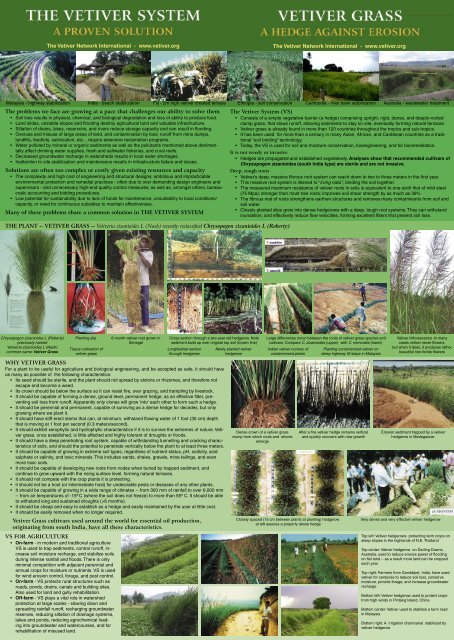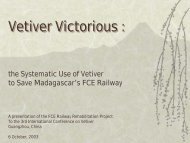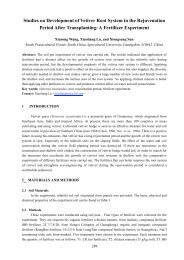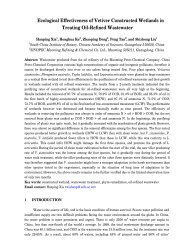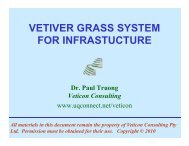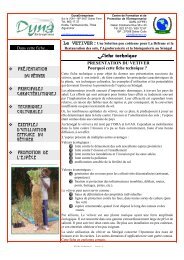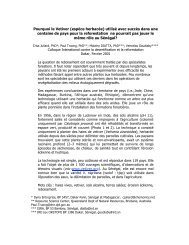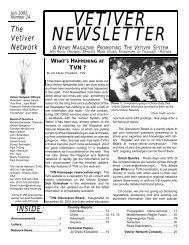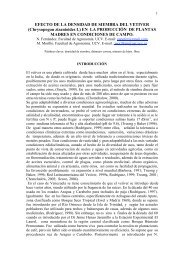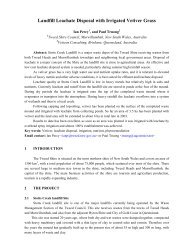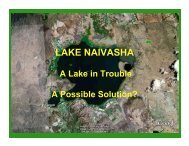small file for screen - The Vetiver Network International
small file for screen - The Vetiver Network International
small file for screen - The Vetiver Network International
Create successful ePaper yourself
Turn your PDF publications into a flip-book with our unique Google optimized e-Paper software.
<strong>The</strong> <strong>Vetiver</strong> <strong>Network</strong> <strong>International</strong> - www.vetiver.org<br />
<strong>The</strong> <strong>Vetiver</strong> <strong>Network</strong> <strong>International</strong> - www.vetiver.org<br />
Malaysia - highway stabilization<br />
India - beach stabilization Fiji - 2m high vetiver created terrace Ethiopia - soil conservation Cambodia - river bank stabilization<br />
<strong>The</strong> problems we face are growing at a pace that challenges our ability to solve them<br />
• Soil loss results in physical, chemical, and biological degradation and loss of ability to produce food.<br />
• Land slides, unstable slopes and flooding destroy agricultural land and valuable infrastructure.<br />
• Siltation of drains, lakes, reservoirs, and rivers reduce storage capacity and can result in flooding.<br />
• Overuse and misuse of large areas of land, and contamination by toxic runoff from mine dumps,<br />
landfills, feedlots, salinization, etc.., require extensive reclamation programs.<br />
• Water polluted by mineral or organic sediments as well as the pollutants mentioned above detrimentally<br />
affect drinking water supplies, fresh and saltwater fisheries, and coral reefs.<br />
• Decreased groundwater recharge in watersheds results in local water shortages.<br />
• Inattention to site stabilization and maintenance results in infrastructure failure and losses.<br />
Solutions are often too complex or costly given existing resources and capacity<br />
• <strong>The</strong> complexity and high cost of engineering and structural designs; ambitious and impracticable<br />
environmental protection and remedial practices - often due to over demanding design engineers and<br />
supervisors - and unnecessary high-end quality control measures; as well as, amongst others, bureaucratic<br />
accounting and bidding procedures.<br />
• Low potential <strong>for</strong> sustainability due to lack of funds <strong>for</strong> maintenance, unsuitability to local conditions/<br />
capacity, or need <strong>for</strong> continuous subsidies to maintain effectiveness.<br />
Many of these problems share a common solution in THE VETIVER SYSTEM<br />
THE PLANT -- VETIVER GRASS -- <strong>Vetiver</strong>ia zizanioides L (Nash) recently reclassified Chrysopogon zizanioides L (Roberty)<br />
Australia - wastewater treatment<br />
<strong>The</strong> <strong>Vetiver</strong> System (VS)<br />
• Consists of a simple vegetative barrier (a hedge) comprising upright, rigid, dense, and deeply-rooted<br />
clump grass, that slows runoff, allowing sediments to stay on site, eventually <strong>for</strong>ming natural terraces.<br />
• <strong>Vetiver</strong> grass is already found in more than 120 countries throughout the tropics and sub-tropics.<br />
• It has been used <strong>for</strong> more than a century in many Asian, African, and Caribbean countries as a traditional<br />
“soil binding” technology.<br />
• Today, the VS is used <strong>for</strong> soil and moisture conservation, bioengineering, and <strong>for</strong> bioremediation.<br />
It is not weedy or invasive<br />
• Hedges are propagated and established vegetatively. Analyses show that recommended cultivars of<br />
Chrysopogon zizanioides (south India type) are sterile and are not invasive.<br />
Deep, tough roots<br />
• <strong>Vetiver</strong>’s deep, massive fibrous root system can reach down to two to three meters in the first year.<br />
• This massive root system is likened to “living nails”, binding the soil together.<br />
• <strong>The</strong> measured maximum resistance of vetiver roots in soils is equivalent to one-sixth that of mild steel<br />
(75 Mpa); stronger than most tree roots; improves soil shear strength by as much as 39%<br />
• <strong>The</strong> fibrous mat of roots strengthens earthen structures and removes many contaminants from soil and<br />
soil water.<br />
• Closely planted slips grow into dense hedgerows with a deep, tough root systems. <strong>The</strong>y can withstand<br />
inundation, and effectively reduce flow velocities, <strong>for</strong>ming excellent filters that prevent soil loss.<br />
Chrysopogon zizanioides L (Roberty)<br />
previously named<br />
<strong>Vetiver</strong>ia zizanioides L (Nash)<br />
common name: <strong>Vetiver</strong> Grass<br />
Planting slip<br />
Tissue cultivation of<br />
vetiver grass<br />
6 month vetiver root grown in<br />
Senegal<br />
Cross section through a two year old hedgerow. Note<br />
sediment build up over original top soil (brown line)<br />
Longitudinal section<br />
through hedgerow<br />
Newly planted vetiver<br />
hedgerow<br />
Large differences occur between the roots of vetiver grass species and<br />
cultivars. Compare C. zizanioides (upper) with C. nemoralis (lower)<br />
Indian vetiver nursery of<br />
containerized plants<br />
Planting containerized vetiver on<br />
steep highway fill slope in Malaysia<br />
<strong>Vetiver</strong> inflorescence. In many<br />
cases vetiver never flowers,<br />
but when it does, it produces rather<br />
beautiful non-fertile flowers<br />
WHY VETIVER GRASS<br />
For a plant to be useful <strong>for</strong> agriculture and biological engineering, and be accepted as safe, it should have<br />
as many as possible of the following characteristics:<br />
• Its seed should be sterile, and the plant should not spread by stolons or rhizomes, and there<strong>for</strong>e not<br />
escape and become a weed.<br />
• Its crown should be below the surface so it can resist fire, over grazing, and trampling by livestock.<br />
• It should be capable of <strong>for</strong>ming a dense, ground level, permanent hedge, as an effective filter, preventing<br />
soil loss from runoff. Apparently only clones will grow 'into' each other to <strong>for</strong>m such a hedge.<br />
• It should be perennial and permanent, capable of surviving as a dense hedge <strong>for</strong> decades, but only<br />
growing where we plant it.<br />
• It should have stiff erect stems that can, at minimum, withstand flowing water of 1 foot (30 cm) depth<br />
that is moving at 1 foot per second (0.3 meters/second).<br />
• It should exhibit xerophytic and hydrophytic characteristics if it is to survive the extremes of nature. <strong>Vetiver</strong><br />
grass, once established, is little affected and highly tolerant of droughts or floods.<br />
• It should have a deep penetrating root system, capable of withstanding tunnelling and cracking characteristics<br />
of soils, and should the potential to penetrate vertically below the plant to at least three meters.<br />
• It should be capable of growing in extreme soil types, regardless of nutrient status, pH, sodicity, acid<br />
sulphate or salinity, and toxic minerals. This includes sands, shales, gravels, mine tailings, and even<br />
more toxic soils.<br />
• It should be capable of developing new roots from nodes when buried by trapped sediment, and<br />
continue to grow upward with the rising surface level, <strong>for</strong>ming natural terraces.<br />
• It should not compete with the crop plants it is protecting.<br />
• it should not be a host (or intermediate host) <strong>for</strong> undesirable pests or diseases of any other plants.<br />
• It should be capable of growing in a wide range of climates -- from 300 mm of rainfall to over 6,000 mm<br />
-- from air temperatures of -15º C (where the soil does not freeze) to more than 55º C. It should be able<br />
to withstand long and sustained droughts (>6 months).<br />
• It should be cheap and easy to establish as a hedge and easily maintained by the user at little cost.<br />
• It should be easily removed when no longer required.<br />
Dense crown of a vetiver grass<br />
clump from which roots and shoots<br />
emerge<br />
After a fire vetiver hedge remains vertical<br />
and quickly recovers with new growth<br />
Erosion sediment trapped by a vetiver<br />
hedgerow in Madagascar.<br />
<strong>Vetiver</strong> Grass cultivars used around the world <strong>for</strong> essential oil production,<br />
originating from south India, have all these characteristics.<br />
VS FOR AGRICULTURE<br />
• On-farm - in modern and traditional agriculture<br />
VS is used to trap sediments, control runoff, increase<br />
soil moisture recharge, and stabilize soils<br />
during intense rainfall and floods. <strong>The</strong>re is only<br />
minimal competition with adjacent perennial and<br />
annual crops <strong>for</strong> moisture or nutrients. VS is used<br />
<strong>for</strong> wind erosion control, <strong>for</strong>age, and pest control.<br />
• On-farm - VS protects rural structures such as<br />
roads, ponds, drains, canals and building sites.<br />
Also used <strong>for</strong> land and gully rehabilitation.<br />
• Off-farm - VS plays a vital role in watershed<br />
protection at large scales - slowing down and<br />
spreading rainfall runoff, recharging groundwater<br />
reserves, reducing siltation of drainage systems,<br />
lakes and ponds, reducing agrochemical loading<br />
into groundwater and watercourses, and <strong>for</strong><br />
rehabilitation of misused land.<br />
Closely spaced (15 cm between plants at planting) hedgerow<br />
at left assures a properly dense hedge<br />
Very dense and very effective vetiver hedgerow<br />
Top left: <strong>Vetiver</strong> hedgerows protecting farm crops on<br />
steep slopes in the highlands of N.E. Thailand<br />
Top center: <strong>Vetiver</strong> hedgerow on Darling Downs,<br />
Australia, used to reduce erosive power of flooding<br />
on flat land -- as a result more land can be cropped<br />
each year<br />
Top right: Farmers from Gundalpet, India, have used<br />
vetiver <strong>for</strong> centuries to reduce soil loss, conserve<br />
moisture, provide <strong>for</strong>age, and increase groundwater<br />
recharge<br />
Bottom left: <strong>Vetiver</strong> hedgerow used to protect crops<br />
from high winds in Pintang Island, China<br />
Bottom center: <strong>Vetiver</strong> used to stabilize a farm road<br />
in Malaysia<br />
Bottom right: A irrigation drain/canal stabilized by<br />
vetiver hedgerow
<strong>The</strong> <strong>Vetiver</strong> <strong>Network</strong> <strong>International</strong> - www.vetiver.org<br />
VS FOR BIO-ENGINEERING<br />
• For the stabilization and protection of infrastructure (roads, railroads, and building sites) VS is proven<br />
effective, efficient, and low cost when compared to other 'hard' engineering alternatives using cement,<br />
rock, and steel. <strong>Vetiver</strong> grass roots have an Mpa of 75 (1/6 the strength of mild steel) and will improve<br />
soil shear strength at a depth of 0.5 meters by as much as 39%. VS costs from 55% to 85% less than<br />
traditional engineering systems. For successful applications cultivars of Chrysopogon zizanioides<br />
originally from south India should be used. <strong>The</strong>se cultivars are of the same genotype as<br />
Monto and Sunshine, and are non-invasive. <strong>The</strong>y have a more massive root structure than non sterile<br />
C.zizanioides accessions from north India, Africa (C.nigratana) and Thailand (C.nemoralis)<br />
<strong>The</strong> <strong>Vetiver</strong> <strong>Network</strong> <strong>International</strong> - www.vetiver.org<br />
<strong>The</strong> KEY to successful VS applications <strong>for</strong> infrastructure is the availability of large quantities of good quality vetiver planting material.<br />
Above, from left to right, are nurseries from Senegal (containerized), China (bare rooted) and Thailand (from in vitro plantlets)<br />
Venezuela - rehabilitation of bauxite mine tailings.<br />
<strong>The</strong> soils are very acid and prone to slippage. High<br />
levels of fertilizer assure good growth<br />
China - expressway stabilization. This cut was prone<br />
to massive slip. Stabilization with VS has given<br />
complete protection<br />
China - unstable highway fill prior to VS treatment.<br />
Road stability was so bad in untreated state that<br />
major lateral cracks in the pavement occurred<br />
China - same fill less than a year later. After another<br />
two years this fill became fully <strong>for</strong>ested. Untreated<br />
cut in background<br />
Spain - unstable and eroding highway fill treated<br />
with VS. Untreated eroded fill on right. VS grows<br />
well under low rainfall Mediterranean climate<br />
Vietnam: the Ho Chi Minh Highway has been<br />
stabilized with vetiver grass. <strong>The</strong> batters and fills<br />
are stable and withstand cyclonic rainfall events<br />
Vietnam - Ho Chi Minh Highway - with and without<br />
vetiver stabilization<br />
Thailand - a gas pipeline was laid through tropical<br />
<strong>for</strong>est. On steep slopes the right of way was<br />
stabilized with vetiver - native plants regenerated<br />
Disaster mitigation - this railroad in Madagascar<br />
was closed down by frequent cyclone damage.<br />
Stabilization with vetiver was vital in its rehabilitation<br />
Congo D.R. - huge gullies that destroy urban areas<br />
and houses can be rehabilitated and stabilized<br />
using the <strong>Vetiver</strong> System.<br />
VS FOR WATER RELATED APPLICATIONS<br />
• VS protects ponds, reservoirs, and rivers banks<br />
from erosion caused by wave action, it strengthens<br />
earthen dams against collapse, and it reduces<br />
maintenance costs and ensures the integrity of<br />
dam walls, canal and river banks, and drains.<br />
• VS improves groundwater recharge through<br />
improved infiltration and reduced rainfall runoff,<br />
and the quality of water by removing sediments<br />
and chemicals.<br />
Venezuela - <strong>Vetiver</strong> withstands flooding <strong>for</strong> long<br />
periods. This grass was flooded <strong>for</strong> 8 months.<br />
<strong>Vetiver</strong> one month after flood receded<br />
China - VS used to stabilize a <strong>small</strong> river<br />
bank located behind hedge allowing the safe<br />
production of crops<br />
Vietnam - <strong>Vetiver</strong> is increasingly used to stabilize the<br />
banks of fishponds and to purify pond water<br />
Australia - VS protects the right hand bank of a<br />
drain cut through acid sulphate soils of Queensland.<br />
Note left hand bank is devoid of any vegetation<br />
China - partially submerged vetiver grass<br />
used to stabilize the draw-down slope of a<br />
reservoir in Guangdong Province<br />
Australia - this river bank and bridge abutment have been<br />
stabilized with vetiver. <strong>Vetiver</strong> is an excellent interface <strong>for</strong><br />
concrete and soil<br />
Zimbabwe - a fast flowing stream<br />
protected from stream bank<br />
erosion using VS application<br />
Australia - schematic of research results showing dramatic drop<br />
of pesticide levels as pesticide laden water moves through vetiver<br />
hedges from right to left. (Green columns = hedges - all other<br />
columns pesticide levels)<br />
Cambodia - This very large bank on the<br />
Mekong River has been under continuous<br />
erosion. <strong>The</strong> land owner with assistance from<br />
TVNI is stabilizing using vetiver hedgerows.<br />
Cambodia - the bank in the previous image<br />
has been reshaped and planted with vetiver<br />
hedgerows. Very good growth seven months<br />
after planting.<br />
Vietnam - cyclone damage to sea dykes<br />
is a major problem. VS has been applied<br />
successfully <strong>for</strong> disaster mitigation<br />
Vietnam - the left hand bank of the canal has<br />
been reshaped and stabilized with vetiver, the<br />
right bank has yet to be treated.<br />
VS FOR BIO-REMEDIATION<br />
• Onsite and offsite pollution control from wastes and contaminants<br />
is a breakthrough application of VS <strong>for</strong> environmental protection.<br />
<strong>Vetiver</strong> is being used to rehabilitate a large copper mine in China,<br />
coal mines in Indonesia, diamond mine spoils in South Africa, to<br />
control erosion and leachate from municipal landfills in China….<br />
and more.<br />
• Research has clearly established vetiver's tolerance to extremely<br />
high levels of Al, Mn, As, Cd, Cr, Ni, Cu, Pb, Hg, Se, and Zn.<br />
• <strong>Vetiver</strong> has been used to reclaim soils and increase site<br />
productivity in places that were previously believed to be totally<br />
unproductive.<br />
<strong>Vetiver</strong> grass will remove phosphate and<br />
nitrate from polluted water. <strong>The</strong> beaker on<br />
the left is be<strong>for</strong>e treatment; on the right 4<br />
days later 90% P and 94% N removed<br />
Australia - VS used as a buffer to<br />
absorb seeping sewage from this holiday<br />
camp site thus reducing runoff and smells<br />
Australia - VS used to stabilize a gold<br />
slimes waste area. <strong>The</strong> hedges reduce<br />
the incidence of wind-blown, cyanidepolluted<br />
dust<br />
Australia - VS used hydroponically on a<br />
pig effluent pond to reduce high levels of<br />
phosphate and nitrate<br />
VS FOR OTHER USES<br />
• In disaster mitigation and vulnerability<br />
reduction, VS has a crucial role to play….<br />
“<strong>The</strong> storms were terrible. [Afterward<br />
there were] landslides, roads destroyed,<br />
agricultural lands washed away; but,<br />
where there were vetiver barriers, everything<br />
seemed normal”. (pers. comm.<br />
Mr. E. Mas, USDA/NRCS after Hurricane<br />
George, Puerto Rico)<br />
• For handicrafts, perfumes, and medicinal<br />
purposes.<br />
• For paper making, mulch, thatch, rein<strong>for</strong>cing<br />
bricks, biofuel, pest control, carbon<br />
sequestering, and many other uses.<br />
Thailand - a selection of handicrafts,<br />
including handbags, vases, lamp shades,<br />
book covers, hats and other crafts from<br />
vetiver grass leaves and stems<br />
Zimbabwe - a nicely thatched meeting house using vetiver<br />
grass thatch. <strong>The</strong> thatch will last three times as many<br />
years due to its resistance to insects and fungus attack<br />
ACT NOW! Contact TVNI <strong>for</strong> additional technical in<strong>for</strong>mation.<br />
<strong>The</strong> <strong>Vetiver</strong> <strong>Network</strong> <strong>International</strong><br />
709 Briar Rd., Bellingham, WA 98225 USA<br />
Tel/Fax: (001) 360-671-5985<br />
E-mail: coordinator@vetiver.org<br />
<strong>The</strong> <strong>Vetiver</strong> <strong>Network</strong> (TVNI) is a nonprofit foundation under United States code 501 (c) (3).<br />
It is a volunteer organization that promotes the use of the <strong>Vetiver</strong> System through dissemination<br />
of in<strong>for</strong>mation and networking worldwide. TVN has helped established over 25 regional<br />
and country-based affiliated networks.<br />
Contact your local vetiver network at:<br />
Home Page: http//www.vetiver.org<br />
<strong>Vetiver</strong> Clients Gallery: http://<br />
picasaweb.google.com/<strong>Vetiver</strong>Clients<br />
<strong>Vetiver</strong> Picture Gallery:http://<br />
picasaweb.google.com/<strong>Vetiver</strong><strong>Network</strong><br />
Blog: http://vetivernetinternational.blogspot.com<br />
FOR SUCCESSFULL VETIVER SYSTEMS APPLICATION ONLY USE CULTIVARS OF CHRYSOPOGON ZIZANIOIDES WITH CHARACTERISTICS OF SOUTH INDIAN GENOTYPES - SUCH AS<br />
SUNSHINE, MONTO, KARNATAKA, FIJI, MADUPATTY. THESE NOT ONLY HAVE GOOD ROOT SYSTEMS, BUT ARE KNOWN TO BE NON-INVASIVE AND ARE EXTENSIVELY RESEARCHED


